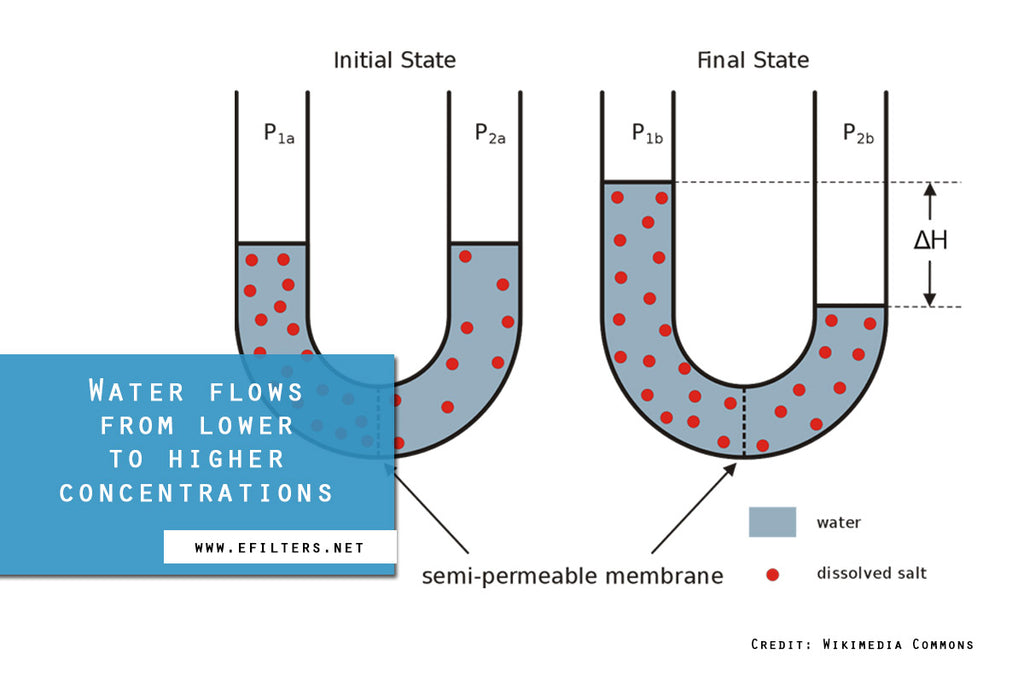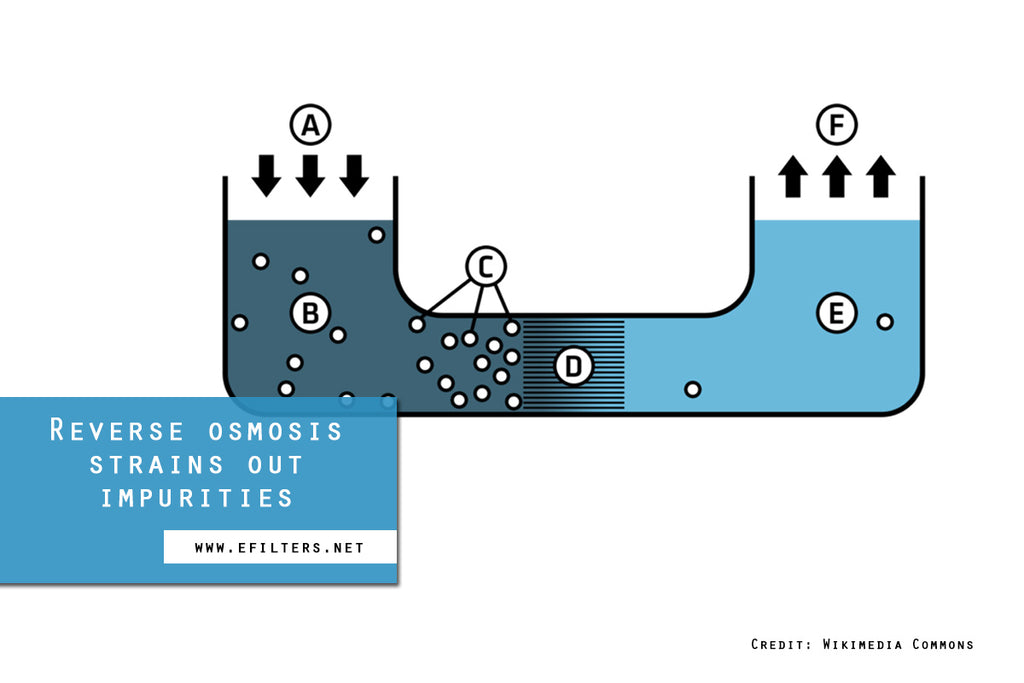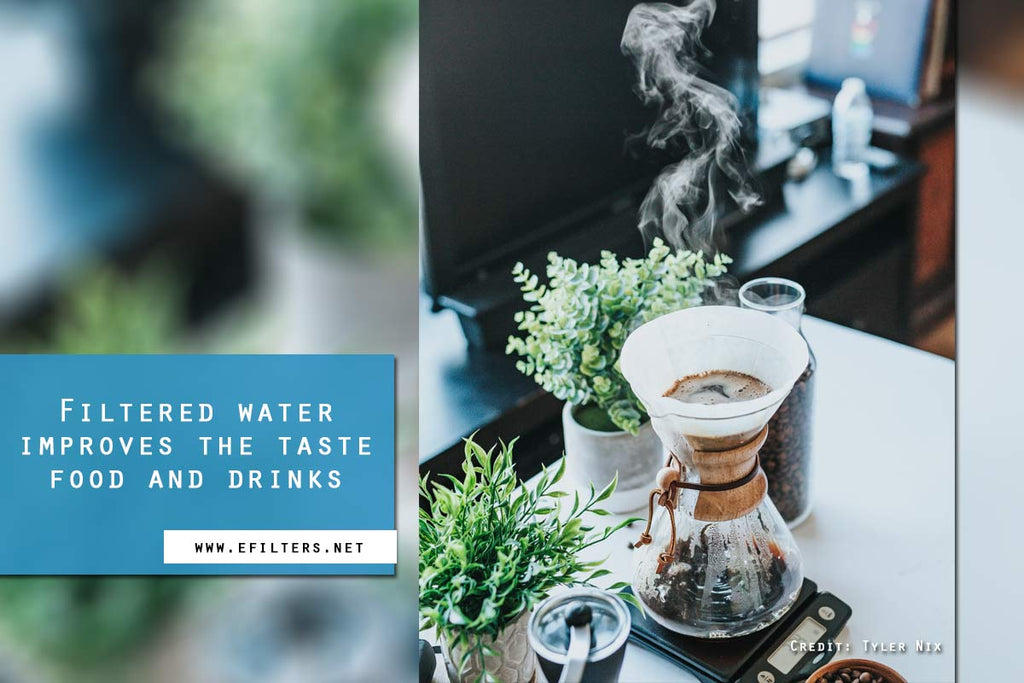How Does Reverse Osmosis Work?

There are several different methods used by filtration systems to purify your water. These include activated carbon, distillation, and reverse osmosis. Reverse osmosis filtration is a commonly used method, but most people do not really understand how it works.
Osmosis
To understand reverse osmosis, we should first understand regular osmosis. Water wants to be at a chemical equilibrium, and osmosis is a natural way that this happens. Weaker solutions naturally migrate toward stronger solutions. If two volumes of water are separated by a semipermeable membrane, the water will flow from the less-concentrated solution to the higher-concentrated one, resulting in two volumes in water with the same concentration of contaminants.

In the image above, the container is divided by a semipermeable membrane. This barrier is dotted with thousands of tiny holes that allow water to pass through. Into one arm, you pour fresh water, and into the other you pour salt water. The level of salt water will slowly rise, as the fresh water flows through the membrane until the salt-to-water ratio on both sides is the same.
Natural examples of osmosis are plants drawing water through their roots, or kidneys absorbing water from blood.
What is Reverse Osmosis?

Reverse osmosis is the reverse of this process, exactly as you might think. However, while osmosis occurs naturally, reverse osmosis is an artificial process, and requires energy to make it work. For example, the Everpure reverse osmosis system applies pressure to the higher-concentrate solution, pushing water through a porous membrane. The pores allow water to pass, but strain out microscopic contaminants (e.g. impurities and bacteria) dissolved in the water. Membranes are usually able to catch particles around .001 micron or larger, leaving you with potable water.
How Reverse Osmosis Filtration Works
Reverse osmosis (RO) systems typically use a 3- to 5-stage system to purify your water and make it safe to drink. An RO system typically has a manifold holding three types of filters, one in each canister, to remove impurities.
- Sediment filter - This filter removes larger particles (e.g. sand, dust, and rust) from water.
- Carbon filter - The carbon filter reduces chemical contaminants (e.g. chlorine) that can give the water a foul taste or smell.
- Semi-permeable membrane - The membrane removes up to 98% of total dissolved solids in your drinking water.
The water runs through the canisters in sequence to remove sediments, chemicals, and dissolved solids. Some of the steps involved in RO filtration include:
- Pre-filtration - Pre-filtration removes dissolved solids and chemicals before exposing the water to the membrane, thus preventing the membrane from clogging easily and from possible damage from larger particles.
- Reverse osmosis membrane - After clearing large particles and chemical impurities, the water flows through the semipermeable membrane, usually made of a synthetic plastic. Water molecules pass easily, but impurities in the water get stuck in the membrane. These impurities can include chemicals like sodium, lead, arsenic, or fluoride. Any bacteria or cysts present are also too large to flow through the membrane, so they are filtered and removed from the water.
- Post-filtration - After the treatment, your water may go through another carbon filter. This helps remove any contaminants that may have made it through the previous stages. After this, the water fills a storage tank until you need it. There is one last carbon filter before the water reaches the tap. This last filter gives the water a final polish to ensure freshness before it comes out.
Reverse osmosis systems can be damaged when hard water is run through them. The hard water can result in scaling on the membrane, defeating the purpose of filtration. Consult with a filtration specialist before installing an RO filtration system check if your local water has high mineral content (i.e. “hard water”).
What happens to filtered contaminants?
RO membranes are self-cleaning, saving you effort on maintenance. When water flows through the system, it divides into two streams. One stream carries clean water to your tap; the other takes the dissolved sediments, salts, and chemicals down the drain. Since the contaminants are washed away, the semipermeable membrane stays unblocked. The charcoal and carbon filters used in other filtration systems can get clogged over time. Buildup can affect their ability to trap particles that pass through them, requiring replacement.
Another bonus of RO is that it reduces the amount of water wasted as part of the filtration process. The water used to carry the contaminants away keeps the system clean, ensuring fresh water at the point of use.
Benefits of Reverse Osmosis
The most obvious benefits of a reverse osmosis filtration system are health-related; however, they can provide other perks as well. Foodservice businesses (e.g. restaurants) in particular can use RO filters to give customers an improved overall dining experience. Here are some ways a RO system can benefit your business.

- It removes contaminants at your tap - Reverse osmosis filters remove contaminants like lead from water at the point of use--your tap. Point of entry systems (eg: water softeners) remove only the contaminants coming into your home or business. Since RO filtration is a point-of-use system, it catches any lead that might leech from your building’s plumbing, as well as what would be caught by the water softener.

- It improved taste - Minerals and chemicals in water can affect taste. By removing impurities, reverse osmosis gives water its natural fresh, pure flavour back. For restaurants and cafes, this can carry over to your food, when you use water filters for steam cooking equipment and combi-ovens. Take advantage of an RO filter to make your business more competitive.
- It takes up less space - RO filters are smaller than most other comparable filters. They can be placed in an unobtrusive location (e.g. under the sink) to avoid it getting in the way or being an unsightly intrusion into a public space.
- It’s easy to maintain - RO systems are typically easy to maintain. They contain few moving or replaceable parts. This makes cleaning and repairs more convenient compared to competing models. Reverse osmosis systems need the filters changed twice a year to operate at peak performance.
- It saves you money - Businesses that use RO filtering can save money. Aside from reduced maintenance costs, filtration reduces the need to buy bottled water. Bottled water is significantly more expensive than tap water. Using filters saves you the cost of buying and transporting bottled water, not to mention disposing of the empties after they are used.
- It lowers your energy costs - Reverse osmosis is generally more energy-efficient than other methods of water purification. RO filters process more water using less energy, allowing you to save more energy.
Maintaining high quality water is vital to continued good health for all Canadians. Use a reverse osmosis filtration system to keep your water clean and fresh for a better experience for customers.
At efilters.net, we provide a variety of filtration systems for your foodservice or home needs. From coffee making to steam ovens, we offer filtering solutions to keep your water pure. Our filters can make your drinks taste great and keep your equipment in tip-top shape. Please contact us at info@efilters.net and let us set you up with the right filter.
